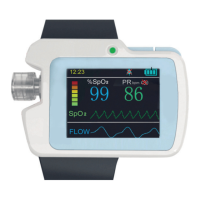Why Gima Measuring Instruments device can not be turned on?
- EElaine FosterAug 13, 2025
If your Gima Measuring Instruments device isn't turning on, the battery might be low or completely drained. Please charge the battery.

Why Gima Measuring Instruments device can not be turned on?
If your Gima Measuring Instruments device isn't turning on, the battery might be low or completely drained. Please charge the battery.
What to do if Gima Measuring Instruments device can not be used for full time after charge?
If your Gima Measuring Instruments device does not work for the expected time after charging, it may be that the battery was not fully charged. Please ensure the battery is fully charged.
Why is the display of nasal airflow unstable on Gima Measuring Instruments?
Unstable nasal airflow display on your Gima Measuring Instruments could be due to: 1. A connection problem. Ensure the device is correctly connected. 2. Incorrect wearing mode. Make sure the device is worn in the correct mode. 3. Patient movement. Keep the patient calm during the measurement.
What to do if Gima Measuring Instruments display disappears suddenly?
If the display on your Gima Measuring Instruments disappears suddenly, it might be entering an energy-saving mode, which is normal. Alternatively, the battery may be low, so try charging the battery.
Why PC can not identify SD card drive letter of Gima Measuring Instruments?
If your PC isn't recognizing the SD card drive letter for your Gima Measuring Instruments, it could be due to a poor connection with the USB interface. Try repeatedly connecting the USB data line.
Why my Gima RS01 Medical Equipment is not powering on?
If your Gima Medical Equipment isn't powering on, it could be due to a lack of battery capacity or a device failure. First, charge the battery immediately. If charging doesn't solve the issue, it may indicate a device failure.
What to do if SpO2 or Pulse rate is displayed abnormally on Gima RS01?
Abnormal SpO2 or pulse rate readings on your Gima Medical Equipment can occur if the finger is not correctly placed, the patient's SpO2 value is outside the measurement range, the finger isn't inserted deeply enough, or the finger is wobbling due to patient movement. Ensure the finger is correctly positioned. If you're sure the device is working correctly, seek a diagnosis from a hospital. Also, ensure the patient remains calm and still during measurement.
Why is the nose air flow waveform display instable on my Gima Medical Equipment?
An unstable nose airflow waveform display on your Gima Medical Equipment can be caused by connection issues, incorrect wearing of the device, or patient movement. Check the connection to ensure it is correctly connected. Make sure you are wearing the device correctly. The patient should remain calm and still during the measurement.
| Brand | Gima |
|---|---|
| Model | RS01 |
| Category | Medical Equipment |
| Language | English |
Outlines the manufacturer's accountability for product safety and performance.
Details the warranty period, coverage, and conditions for repair or replacement.
Explains the meaning of common symbols and labels used in the manual.
Provides essential guidelines for safe operation and testing of the device.
Highlights potential hazards and crucial precautions to prevent injury or damage.
Offers important considerations and precautions for proper device usage.
Introduces the sleep apnea screen meter and its primary applications.
Lists the main capabilities and operational features of the device.
Lists the items provided with the sleep apnea screen meter.
Identifies and describes the device's physical buttons and connection ports.
Explains the different display interfaces and their indicators on the device.
Details how to use the power, awake, and menu/confirm buttons.
Guides users through the device's menu system for various setups and functions.
Explains how to connect and properly use the nasal cannula and SpO2 probes.
Lists conditions and factors that may affect measurement accuracy or usability.
Covers timed powering functions and uploading data via USB.
Describes the methods for charging the device's battery.
Guides on importing patient data and managing cases using the software.
Explains how to set up hospital information and display parameters in the software.
Details how to view and adjust waveforms for analysis.
Covers various menus like File, Edit, View for data analysis and reporting.
Provides instructions for cleaning the device and its accessories.
Explains the recommended methods for disinfecting the device.
Offers advice on regular checks and care for device longevity.
Details the device's compliance with electromagnetic emission standards.
Outlines the device's compliance with electromagnetic immunity standards.
Specifies the conditions and duration of the product warranty.
Provides guidance on the proper disposal of the device.
